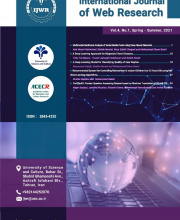۱.
“AppTree” is an intelligent platform to bring researchers, visitors, and all interested people closer to the oldest and most attractive botanical garden at the University of Tehran. AppTree can scan the QR-Barcode of each plant in person by smartphone or search various plants on the website and get all the useful knowledge about them. Also, the ability of AppTree is the recognition of different plants which don’t have labels. The plant recognition part is a machine learning module that can identify more than 100 different species of plants and give the user details about them. This novel platform is based on Android and Web-app and the identification of new plants type is done by machine learning approach. We utilized VGG19, a deep CNN, to classify images and to identify unlabeled plants. The classification accuracy, F1-score, recall, and precision were 98.25, 93.16%, 88.21%, and 94.85%, respectively, on the plant dataset of the University of Tehran. The proposed method was compared with other deep learning architectures such as AlexNet, AlexNetOWTBn, and GoogLeNet on the same dataset and obtained higher performance. Our AppTree platform has achieved considerable success and easily can be extended to use in other botanical gardens.
۲.
The Internet has become an important part of many people’s daily activities. Therefore, numerous attacks threaten Internet users. IDS is a network intrusion detection tool used to quickly identify and categorize intrusions, attacks, or security issues in network-level and host-level infrastructure. Although much research has been done to improve IDS performance, many key issues remain. IDSs need to be able to more accurately detect different types of intrusions with fewer false alarms and other challenges. In this paper, we attempt to improve the performance of IDS using Whale Optimization Algorithm (WOA). The results are compared with other algorithms. NSL-KDD dataset is used to evaluate and compare the results. K-means clustering was chosen for pre-processing after a comparison between some of the existing classifier algorithms. The proposed method has proven to be a competitive method in terms of detection rate and false alarm rate base on a comparison with some of the other existing methods.
۳.
Heart disease pretends great danger to people, as heart disease has recently become a dangerous disease that acts as a threat to humans. It usually affects all groups from young to old. The biggest challenge in this paper is data pre-processing and discovering a solution to the failure of records Clinical heart, where an effective high-performance model is proposed to enhance heart disease and treat failure in the clinical heart failure records. The current authors applied the techniques of clustering with k-means, expectation-maximization clustering, DBSCAN, support vector clustering, and random clustering herein. Using cluster techniques, we gained good enough results for significantly predicting and improving the performance of heart disease. The goal of the model is a suggestion of a reduction method to find features of heart disease by applying several techniques. Our most important results are to predict faster and better. It indicates that the proposed model is excellent and gives excellent results. This model demonstrated a great superiority over its counterparts through the results obtained in this research. We obtained some values of 130, 980, 183, 125.133, 133, 203, and 125.800. It confirms that this model will predict significantly and improve the performance of the data that we have worked on this.
۴.
We present FarsWikiKG, a Persian knowledge graph extracted from Wikipedia. Wikipedia infoboxes have been used as a valuable resource for building knowledge graphs in recent years. FarsWikiKG consists of more than 2 million entities, as well as 5.7 million facts about the entities. Using Wikidata, we constructed an ontology with more than 6000 classes representing entity types. As the second Persian knowledge graph, which has the ability of self-update, FarsWikiKG shows improvement on NLP tasks, especially question answering systems. Although FarsWikiKG is a dynamic knowledge graph, our evaluation shows a coverage of 90% on Persian Wikipedia pages. As Wikipedia information is constantly changing, a fixed knowledge graph can provide unstable data to the user. The proposed system, in addition to solving the problem of unstable data, reduces the need for experts to extract and construct knowledge graphs manually. Storing information in RDF as a standard method of storing knowledge graph information, FarsWikiKG allows NLP systems to run SPARQL queries on it.
